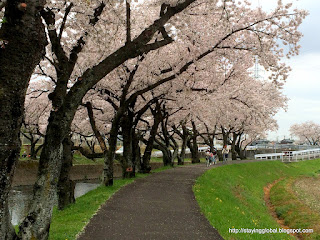Cherry Blossoms are abundant all over Japan. There are quite a few spots across the country which are well known for viewing Cherry Blossoms. While some spots are popular due to the variety of Cherry Blossoms, others are known for the scenic beauty of the place with the added charm of Cherry Blossoms. Some spots are known for the number of Cherry Blossom trees. There are a few such spots in and around Nagoya, where hundreds of Cherry trees create a seasonal tourist attraction. One such spot is the Gojo riverside near Nagoya which we visited in Spring 2015.
A riverside promenade, some stone buildings, the Ki-bashi and Saidan-bashi bridges and the blossom laden cherry trees make for a pretty sight.
The spot that we visited was the Horioseki Park in Oguchi-cho.
Needless to say, this is a popular Hanami spot among locals. We enjoyed a barbecue lunch under the Cherry trees and it truly was a memorable experience.
About 1400 cherry trees line both sides of the Gojo river.
Further along the Gojo riverside,in Iwakura city, an unique event called 'Nonbori arai", washing of Carp streamers (known as Koi nobori in Japanese), in the Gojo river is held on a weekend.
The lanterns hanging from the Cherry trees are lit up every evening between 6pm and 9 pm during the Sakura matsuri, (Cherry Blossom festival).
Elsewhere in Iwakura city, Japanese festival floats, known as Dashi in Japanese, are paraded through the streets during the annual Cherry Blossom festival. The floats are decorated with mechanical dolls well known for the display of acrobatic movements.
Address of Horioseki Park: Aichi Prefecture 480-0136, Niwa gun, Horioseki 1 Chome
Phone no: 0587-95-1111 ( Oguchi Town Urban Development Division)
Parking: Free parking available for 30 cars
Entrance Fees: Free


















































